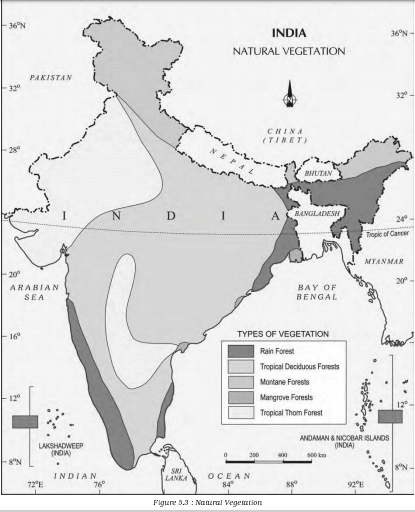-
16 Jan 2025
GS Paper 1
Geography
Day 40: Discuss the distribution and characteristics of the evergreen forest in India. (150 Words)
Approach
- Introduce evergreen forests, highlighting their ecological and climatic requirements.
- In the Body, describe the distribution and features of evergreen forests, providing specific examples.
- Conclude with their importance and the need for conservation.
Introduction
Evergreen forests, known for their lush, dense canopy and year-round greenery, thrive in regions with high rainfall (200 cm or more) and consistent temperatures (22°C–27°C). These forests are critical for biodiversity conservation, climate regulation, and supporting unique ecosystems in India.
Body
Distribution of Evergreen Forests in India:
- Western Ghats:
- Spread across Kerala, Karnataka, Tamil Nadu, and Maharashtra, they are found in areas like Silent Valley and Agasthyamalai Biosphere Reserve.
- These forests host endemic species like the Nilgiri Tahr and Malabar Civet.
- Northeastern States:
- Found in Assam, Arunachal Pradesh, Meghalaya, Nagaland, and Manipur, especially in regions like Kaziranga and Dibang Valley.
- These forests are rich in orchids and ferns.
- Andaman and Nicobar Islands:
- Home to tropical evergreen forests, particularly in the Great Nicobar Biosphere Reserve.
- Unique species like the Nicobar Megapode are found here.
- Eastern Ghats and Coastal Regions:
- Present in patches acrossOdisha, Andhra Pradesh, and West Bengal, especially near coastal plains and deltas.
Characteristics of Evergreen Forests:
- Dense Canopy: Thick tree cover allows limited sunlight to reach the forest floor.
- Diverse Flora: Dominated by species like mahogany, rosewood, and ebony, along with abundant climbers and epiphytes.
- Year-Round Greenery: Trees shed leaves at different times, maintaining continuous greenery.
- High Biodiversity: These forests are hotspots for endemic species, including the Lion-tailed Macaque in the Western Ghats.
- High Productivity: Significant contributors to carbon sequestration and oxygen production.
Conclusion
Evergreen forests are vital to India’s ecological stability and biodiversity. However, threats like deforestation and climate change necessitate urgent conservation measures. Sustainable management and community participation can ensure their preservation for future generations.





